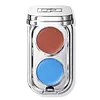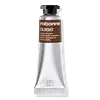Paco Rabanne Eyephoria Mini Eyeshadow Palette Duo Versus Paco Rabanne Eyephoria Colorshot Liquid Eyeshadow
What's inside
What's inside
 Key Ingredients
Key Ingredients

 Benefits
Benefits

 Concerns
Concerns

 Ingredients Side-by-side
Ingredients Side-by-side

Polybutene
Diisostearyl Malate
EmollientPolyglyceryl-2 Tetraisostearate
EmollientVp/Hexadecene Copolymer
Trimethylsiloxyphenyl Dimethicone
Mica
Cosmetic ColorantDicalcium Phosphate
AbrasiveSynthetic Wax
AbrasiveCopernicia Cerifera Wax
Pentaerythrityl Tetra-Di-T-Butyl Hydroxyhydrocinnamate
AntioxidantKaolin
AbrasiveCI 77891
Cosmetic ColorantCI 77742
Cosmetic ColorantCI 77491
Cosmetic ColorantCI 77492
Cosmetic ColorantCI 77499
Cosmetic ColorantCI 42090
Cosmetic ColorantCI 19140
Cosmetic ColorantCI 77007
Cosmetic ColorantPolybutene, Diisostearyl Malate, Polyglyceryl-2 Tetraisostearate, Vp/Hexadecene Copolymer, Trimethylsiloxyphenyl Dimethicone, Mica, Dicalcium Phosphate, Synthetic Wax, Copernicia Cerifera Wax, Pentaerythrityl Tetra-Di-T-Butyl Hydroxyhydrocinnamate, Kaolin, CI 77891, CI 77742, CI 77491, CI 77492, CI 77499, CI 42090, CI 19140, CI 77007
Water
Skin ConditioningSynthetic Fluorphlogopite
Mica
Cosmetic ColorantLauryl Dimethicone
Skin ConditioningButyrospermum Parkii Butter
Skin ConditioningButylene Glycol
HumectantHydrogenated Polycyclopentadiene
Glycerin
HumectantIsododecane
EmollientAmmonium Acryloyldimethyltaurate/Beheneth-25 Methacrylate Crosspolymer
Emulsion StabilisingPolyglyceryl-4 Caprate
EmulsifyingPolyglyceryl-3 Polyricinoleate
EmulsifyingHydroxyacetophenone
AntioxidantPanthenol
Skin ConditioningPhenoxyethanol
PreservativeSilica
AbrasiveHydrogenated Lecithin
EmulsifyingSimethicone
EmollientAscorbyl Palmitate
AntioxidantTocopherol
AntioxidantPolyglyceryl-3 Diisostearate
EmulsifyingHydrolyzed Vegetable Protein
Skin ConditioningKaolin
AbrasiveCI 77491
Cosmetic ColorantCI 77492
Cosmetic ColorantCI 77499
Cosmetic ColorantCI 77891
Cosmetic ColorantCI 77007
Cosmetic ColorantWater, Synthetic Fluorphlogopite, Mica, Lauryl Dimethicone, Butyrospermum Parkii Butter, Butylene Glycol, Hydrogenated Polycyclopentadiene, Glycerin, Isododecane, Ammonium Acryloyldimethyltaurate/Beheneth-25 Methacrylate Crosspolymer, Polyglyceryl-4 Caprate, Polyglyceryl-3 Polyricinoleate, Hydroxyacetophenone, Panthenol, Phenoxyethanol, Silica, Hydrogenated Lecithin, Simethicone, Ascorbyl Palmitate, Tocopherol, Polyglyceryl-3 Diisostearate, Hydrolyzed Vegetable Protein, Kaolin, CI 77491, CI 77492, CI 77499, CI 77891, CI 77007
Ingredients Explained
These ingredients are found in both products.
Ingredients higher up in an ingredient list are typically present in a larger amount.
This pigment is called Ultramarine blue lazurite. It gives a saturated blue color, but can be used to create other colors as well.
According to the manufacturer, it is usually made from kaolin, sodium sulfate, sodium carbonate, sulfur, and charcoal.
Ci 77491 is also hydrated iron III oxide. It's sole purpose is to give a red/pink hue to products.
Iron III oxides are classified as inorganic chemicals for coloring.
Synthetically created Ci 77491 is considered safer than those naturally found. This is because the synthetically created version may contain less impurities. Iron oxides are generally non-toxic and non-allergenic.
Learn more about CI 77491Ci 77492 is also hydrated iron III oxide. It's sole purpose is to give a yellow hue to products.
Iron III oxides are classified as inorganic chemicals for coloring.
Synthetically created Ci 77492 is considered safer than those naturally found. This is because the synthetically created version may contain less impurities. Iron oxides are generally non-toxic and non-allergenic.
Learn more about CI 77492Ci 77499 is also hydrated iron III oxide. It is created from mixing red and black iron oxides. This helps give shades of darkness to a product.
Iron III oxides are classified as inorganic chemicals for coloring.
Ci 77891 is a white pigment from Titanium dioxide. It is naturally found in minerals such as rutile and ilmenite.
It's main function is to add a white color to cosmetics. It can also be mixed with other colors to create different shades.
Ci 77891 is commonly found in sunscreens due to its ability to block UV rays.
Learn more about CI 77891Kaolin is a clay. It is used for oil control and to help minimize pores. Like other clays, kaolin has the ability to absorb excess sebum or oil. This can help clean out pores and mattify the skin.
Some types of kaolin may have exfoliating properties. When water is added to kaolin, it becomes a paste with small abrasive particles.
Most kaolin is a white color, but may be pink/orange/red depending on where it comes from.
The name 'kaolin' comes from a Chinese village named 'Gaoling'. Kaolin clay comes from rocks rich in kaolinite. Kaolinite, the mineral, has a silicate layered structure. Kaolinite is formed from chemical weathering of aluminum siilicate minerals.
Besides skincare, kaolin is commonly used to make glossy paper, in ceramics, toothpaste, and as medicine to soothe stomach issues.
Learn more about KaolinMica is a naturally occurring mineral used to add shimmer and color in cosmetics. It can also help improve the texture of a product or give it an opaque, white/silver color.
Serecite is the name for very fine but ragged grains of mica.
This ingredient is often coated with metal oxides like titanium dioxide. Trace amounts of heavy metals may be found in mica, but these metals are not harmful in our personal products.
Mica has been used since prehistoric times throughout the world. Ancient Egyptian, Indian, Greek, Roman, Aztec, and Chinese civilizations have used mica.
Learn more about Mica